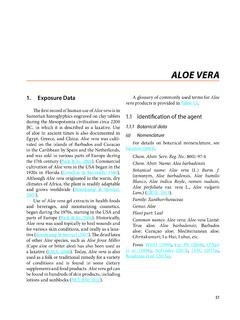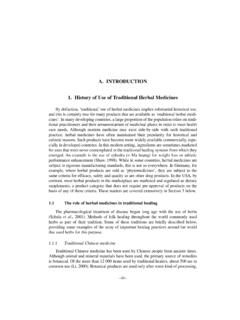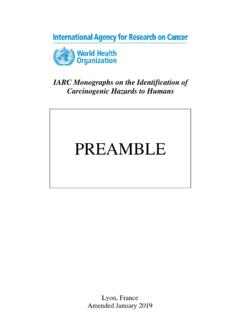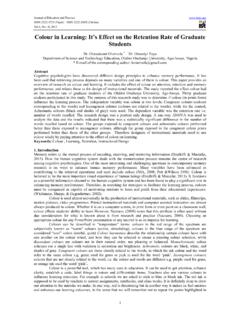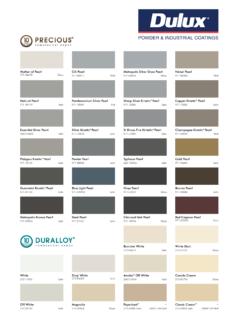Transcription of GENERAL INTRODUCTION TO THE CHEMISTRY OF DYES 1.
1 55 GENERAL INTRODUCTION TO THE CHEMISTRY OF DYES 1. Principles of colour CHEMISTRY Basis for colour Unlike most organic compounds, dyes possess colour because they 1) absorb light in the visible spectrum (400 700 nm), 2) have at least one chromophore ( colour -bearing group), 3) have a conjugated system, a structure with alternating double and single bonds, and 4) exhibit resonance of electrons, which is a stabilizing force in organic compounds (Abrahart, 1977). When any one of these features is lacking from the molecular structure the colour is lost. In addition to chromophores, most dyes also contain groups known as auxochromes ( colour helpers), examples of which are carboxylic acid, sulfonic acid, amino, and hydroxyl groups.
2 While these are not responsible for colour , their presence can shift the colour of a colourant and they are most often used to influence dye solubility. Figure 1 shows the relationships between wavelength of visible and colour absorbed/observed. Other factors contributing to colour are illustrated in Figures 2 4. Fig. 1. Wavelength of light absorption versus colour in organic dyes Wavelength Absorbed (nm) colour Absorbed colour Observed 400 435 Violet Yellow-Green 435 480 Blue Yellow 480 490 Green-Blue Orange 490 500 Blue-Green Red 500 560 Green Purple 560 580 Yellow-Green Violet
3 580 595 Yellow Blue 595 605 Orange Green-Blue 605 700 Red Blue-Green 56 IARC MONOGRAPHS VOLUME 99 Fig. 2. Examples of chromophoric groups present in organic dyes NNNOOCArArAz oNitroTriarylmethaneNNNNNNNNHHM ethinePhthalocyanineAnthraquinoneCNOO Fig. 3. Conjugated systems in Vitamin A (top) and -carotene (bottom) CH3CH3CH3CH2 OHCH3CH31110987654321CH3CH3CH3CH3CH3CH3C H3CH3H3CH3C12345 Fig. 4. A pair of resonance structures for Malachite Green ( Basic Green 4) (CH3)2NN(CH3)2N(CH3)2(CH3)2N Regarding the requirement of a chromophore generating colour in organic compounds, it is important to note that the chromophore must be part of a conjugated system.
4 This is illustrated through the examples in Figure 5 where it can be seen that placement of an azo group between methyl groups produces a colourless compound, while a yellow-orange colour is obtained when the azo group is placed between aromatic rings. Similarly, the structures in Figure 3 demonstrate the importance of having an extended conjugated system. It is evident that doubling the length of the conjugated CHEMISTRY OF DYES 57 system in Vitamin A to give -carotene causes a significant bathochromic shift, to a darker colour . Fig. 5. Importance of having a chromophore within a conjugated system OrangeNNCH3 NNCH3 Colourless In addition to influencing solubility, auxochromes are essential ring substituents in providing target colours.
5 This is illustrated in Figure 6, where the following effects of substituents are shown: Adding groups of increasing electron-donating ability to the azobenzene structure has a bathochromic effect (cf. OH vs NH2). Electron-donating (NH2) and electron-accepting (NO2) groups placed in conjugation provide a bathochromic effect. In this regard, nitro groups are especially beneficial, contributing to their prevalence in disperse dye structures. Increasing the number of electron-attracting groups conjugated with the electron-donor has a bathochromic effect. The electron-donating effects of an amino group are enhanced by adding alkyl groups to the N-atom. Fig. 6. Effects of substituent groups within an azo-dye system NNN(CH2CH3)CH2CH2 OHO2N502 nm517 nmNNN(CH2CH3)CH2CH2 OHO2 NClNNOHNNNH2 NNNH2O2N347 nm386 nm443 nm Dyes versus Pigments With regard to their solubility, organic colourants fall into two classes, viz.
6 Dyes and pigments (Allen 1971). The key distinction is that dyes are soluble in water and/or an organic solvent, while pigments are insoluble in both types of liquid media. Dyes are used to colour substrates to which they have affinity. Pigments can be used to colour any 58 IARC MONOGRAPHS VOLUME 99 polymeric substrate but by a mechanism quite different from that of dyes, in that surface-only colouration is involved unless the pigment is mixed with the polymer before fibre or moulded article formation. 2. Considerations in Dye Design Dye-substrate affinity Dyes containing one or more azo groups ( azo dyes) comprise by far the largest family of organic dyes. Prominent types are 1) acid dyes for polyamide and protein substrates such as nylon, wool, and silk; 2) disperse dyes for hydrophobic substrates such as polyester and acetate, and 3) direct and reactive dyes for cellulosic substrates such as cotton, rayon, linen, and paper.
7 Generally, the synthesis of azo dyes involves two steps. Step 1 is the conversion of an aromatic amine to a diazo compound ( Ar-NH2 Ar-N2+), a process known as diazotization, and step 2 is the reaction of the diazo compound with a phenol, naphthol, aromatic amine, or a compound that has an active methylene group, to produce the corresponding azo dye, a process known as diazo coupling ( Ar- N2+ + Ar -OH Ar-N=N-Ar -OH). This process is suitable for forming both azo dyes and pigments. Typical structures of colourants that fall into the two groups are shown in Figure 7. Since the effectiveness of a dyeing or printing process often hinges on the affinity between the dye and substrate, dyes are designed with a specific substrate in mind. In this regard, dyes must be designed that have a) greater affinity for the substrate than the medium (usually water) from which it is applied and b) a high degree of permanence under end-use conditions ( stability to fading upon exposures to water (wet fast) and/or sunlight (light fast)).
8 The following is a summary of the types of considerations associated with the development of dyes for polymeric (especially fibre-based) substrates (Aspland, 1997). The availability of colourants for a specific substrate type is the result of a deliberate molecular design process that takes the target substrate and end-use application into consideration. Dyes for polyesters Dyes developed for polyesters are known as disperse dyes. In this case, the mechanism of coloration involves dissolving the dye in the polymer matrix to form a solid solid solution. Taking advantage of the well known principle that like dissolves like , disperse dyes are designed that are hydrophobic in nature. Such colourants are very sparingly soluble in water and derive their name from the fact that they are dispersed rather than fully dissolved in water to carry out the dyeing process.
9 An example is Disperse Blue 165 (Figure 7). Disperse dyes have no affinity for hydrophilic polymers CHEMISTRY OF DYES 59 such as cellulose, which makes them unsuitable for colouring cotton, cellophane, and paper, but quite suitable for poly(ethylene terephthalate) and cellulose acetate. Fig. 7. Structures of some commercial azo dyes and pigments NO2 NNN(CH2CH3)2 NHCOCH3 CNCNNNNNHCONaO3 SOHNNaO3 SDirect Red 81 Disperse Blue 165 Pigment Yellow 14 NNClClNNONHOMeHOMeHONHMeMe Dyes for polyamides and proteins Dyes for these substrates normally form ionic bonds (Fig. 8) within the polymer matrix. In this case dyes bearing a negative (anionic) charge are used because polyamides such as nylon and proteins such as wool, silk, and leather carry a positive (cationic) charge especially during the dyeing process.
10 Anionic dyes for polyamide and protein substrates are known as acid dyes, an example of which is Acid Black 1 (Fig. 9). They derive their name from the fact that they are typically applied to suitable substrates from a medium containing acid. These dyes have little to no affinity for polyester, cellulosic, or cationic polymers, since such substrates cannot form an ionic bond with them. Fig. 8. Schematic representation of dye polymer binding via ionic bonding on nylon Dye-SO3 Na + Nylon-NH3 ClDye-SO3 H3N-Nylon 60 IARC MONOGRAPHS VOLUME 99 Fig. 9. Structure of a commercial acid and cationic (basic) dye NH2 NNaO3 SOHNSO3 NaNNO2 NAcid Black 1 ClO2 NNNNCH2CH2N(CH3)3 Cl CH2CH3 Basic Red 18 Dyes for cationic polymers Dyes for these substrates also form ionic bonds within the polymer matrix.




